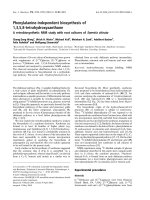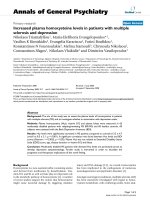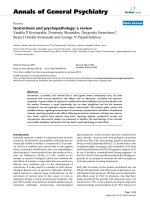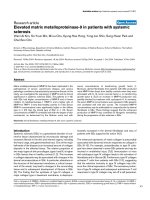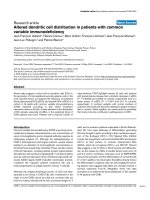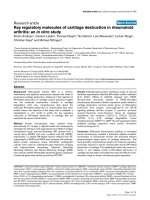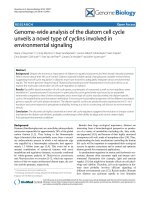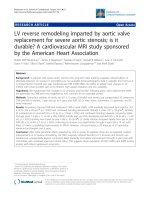Báo cáo y học: "Characteristics and outcomes of trauma patients with ICU lengths of stay 30 days and greater: a seven-year retrospective study" pdf
Bạn đang xem bản rút gọn của tài liệu. Xem và tải ngay bản đầy đủ của tài liệu tại đây (199.6 KB, 9 trang )
Open Access
Available online />Page 1 of 9
(page number not for citation purposes)
Vol 13 No 5
Research
Characteristics and outcomes of trauma patients with ICU lengths
of stay 30 days and greater: a seven-year retrospective study
Adrian W Ong
1
, Laurel A Omert
2
, Diane Vido
3
, Brian M Goodman
1
, Jack Protetch
1
,
Aurelio Rodriguez
1
and Elan Jeremitsky
1
1
Department of Surgery, Allegheny General Hospital, 320 East North Avenue, Pittsburgh PA 15212, USA
2
Northfield Laboratories Inc., 1560, Sherman Avenue, Evanston, IL 60201, USA
3
Department of Cardiology, Allegheny General Hospital, 320 East North Avenue, Pittsburgh PA 15212, USA
Corresponding author: Adrian W Ong,
Received: 30 May 2009 Revisions requested: 20 Jul 2009 Revisions received: 6 Sep 2009 Accepted: 24 Sep 2009 Published: 24 Sep 2009
Critical Care 2009, 13:R154 (doi:10.1186/cc8054)
This article is online at: />© 2009 Ong et al; licensee BioMed Central Ltd.
This is an Open Access article distributed under the terms of the Creative Commons Attribution License ( />2.0), which permits unrestricted use, distribution, and reproduction in any medium, provided the original work is properly cited.
Abstract
Introduction Prolonged intensive care unit lengths of stay (ICU
LOS) for critical illness can have acceptable mortality rates and
quality of life despite significant costs. Only a few studies have
specifically addressed prolonged ICU LOS after trauma. Our
goals were to examine characteristics and outcomes of trauma
patients with LOS ≥ 30 days, predictors of prolonged stay and
mortality.
Methods All trauma ICU admissions over a seven-year period in
a level 1 trauma center were analyzed. Admission
characteristics, pre-existing conditions and acquired
complications in the ICU were recorded. Logistic regression
was used to identify independent predictors of prolonged LOS
and predictors of mortality among those with prolonged LOS
after univariate analyses.
Results Of 4920 ICU admissions, 205 (4%) had ICU LOS >30
days. These patients were older and more severely injured. Age
and injury severity score (ISS) were associated with prolonged
LOS. After logistic regression analysis, sepsis, acute respiratory
distress syndrome, and several infectious complications were
important independent predictors of prolonged LOS. Within the
group with ICU LOS >30 days, predictors of mortality were age,
pre-existing renal disease as well as the development of renal
failure requiring dialysis. Overall mortality was 12%.
Conclusions The majority of patients with ICU LOS ≥ 30 days
will survive their hospitalization. Infectious and pulmonary
complications were predictors of prolonged stay. Further efforts
targeting prevention of these complications are warranted.
Introduction
Prolonged intensive care unit (ICU) stays for critical illness can
result in acceptable mortality rates and quality of life despite
significant costs [1,2]. Only a few studies have specifically
addressed prolonged ICU lengths of stay (LOS) after trauma
[3-5]. Our goals were to determine the outcomes and charac-
teristics of trauma patients with prolonged ICU LOS. Based
on previous studies of medical and surgical ICU patients, our
hypotheses were that age and injury severity predicted pro-
longed ICU LOS in trauma patients admitted to the ICU, but
that the majority of trauma patients who survived beyond 30
days in the ICU would survive to discharge.
Materials and methods
This was a retrospective study based on the hospital trauma
registry over a seven-year period (1998 to 2004) approved by
the hospital Institutional Review Board with waiver of consent.
In this level I trauma center, critical care services for injured
patients are provided by the same trauma physician group that
admits injured patients. Admission clinical characteristics, pre-
existing conditions and acquired complications in the ICU
were extracted from registry data. Selected definitions used
for this study for pre-existing conditions and complications are
based on those set by the Pennsylvania Trauma Systems
Foundation [see Additional data file 1].
ARDS: acute respiratory distress syndrome; GCS: Glasgow Coma Score; ICU: intensive care unit; ILOS<30: patients with ICU length of stay less
than 30 days; ILOS>30: patients with ICU length of stay greater or equal to 30 days; ISS: Injury Severity Score; LOS: length of stay; MOF: multiple
organ failure.
Critical Care Vol 13 No 5 Ong et al.
Page 2 of 9
(page number not for citation purposes)
For the purposes of this study, the control group was desig-
nated as those patients who were admitted to the ICU for less
than 30 days (ILOS<30). This group was compared with the
group with ICU LOS of 30 days or greater (ILOS>30). Within
the ILOS>30 group, we also compared survivors with non-sur-
vivors (Figure 1).
Data were summarized as mean ± standard deviation. To com-
pare means, we used the independent samples t test and the
Mann-Whitney U rank sum test. Logistic regression was used
to identify independent predictors of prolonged LOS in the
entire sample as well as independent predictors of mortality
within the ILOS>30 subgroup. Correlation was assessed
using Spearman's rho. Chi-squares and nested chi-squares
analyses were used to explore relations between variables.
Differences were considered significant at P < 0.05. SPSS
version 14.0 (SPSS Inc., Chicago, IL, USA) was used to ana-
lyze the data.
Results
Comparison of ILOS>30 and ILOS<30 groups
There were 11,035 admissions to the trauma service in the
seven-year study period, with 4920 (44.5%) patients admitted
to the ICU. ICU LOS for the 4920 patients is shown in Figure
2. The ILOS>30 group (n = 205) had a mean LOS of 45.5 ±
23.8 days (median 39, range 30 to 279 days) with a mean
mechanical ventilation duration of 39.9 ± 21.1 days (median
38, range 7 to 192 days). ILOS>30 patients comprised only
4% of all ICU patients, but accounted for 8350 bed days
(29%) out of a total of 28,771 bed days and 6742 ventilator
days (41%) out of a total of 16,335 during this study period.
Demographic and clinical characteristics are shown in Table
1. ILOS>30 patients were significantly older, more severely
injured, and had lower Glasgow Coma Scores (GCS) on
admission. A modest positive correlation existed between ill-
ness severity score (ISS) and ICU LOS (Spearman's rho =
0.4, P < 0.001). The LOS>30 patients group also had signif-
icantly higher incidences of pre-existing cardiac, renal, pulmo-
nary conditions and diabetes mellitus. Not surprisingly,
ILOS>30 patients sustained significantly more complications
in the ICU.
Of the 4920 patients, 3421 (69.5%) were younger than 65
years old compared with 1499 (30.5%) who were 65 years
old or older. ICU LOS was significantly associated with patient
age (<65 versus >65 years old) when controlled for injury
severity except in the least severely injured and most severely
injured categories (Table 2). Age was also significantly asso-
ciated with mortality. Patients 65 years and older had a mortal-
ity rate of 24.4% compared with 6.7% for younger patients (P
< 0.001). When controlled for injury severity, the association
of mortality with age was significant for all degrees of injury
severity (Table 3). For the ISS 1-3 patients who died, three had
no autopsies (and therefore potential injuries may not have
been delineated completely), three suffered anoxic brain injury
after hanging and drowning accidents, and one died from
necrotizing fasciitis after sustaining minor soft tissue trauma
10 days previously.
Univariate analysis produced the following predictors of ICU
stay of more than 30 days: age over 65 years, ISS > 21
(Receiver operating characterstic curve [ROC] analysis; sen-
sitivity 72% [95% C.I. 65%, 78%], specificity 64% [95% C.I.
63%, 66%]), GCS <12 (ROC curve analysis; sensitivity 43%
[95% C.I. 36%, 50%], specificity 73% [95% C.I. 72%, 75%]),
pre-existing cardiac, renal, pulmonary or diabetic conditions,
and complications that developed during ICU stay (all P <
0.05).
Variables with P < 0.2 by univariate analysis were entered into
a logistic regression analysis to create a prediction model for
Figure 1
Composition of the study groupsComposition of the study groups. ILOS<30 = patients with intensive care unit (ICU) length of stay less than 30 days; ILOS>30 = patients with ICU
length of stay greater than or equal to 30 days.
Available online />Page 3 of 9
(page number not for citation purposes)
ICU LOS of 30 days or longer. The P value was set at 0.2
because some variables may prove to have lower P values in
a model or to be important confounders. Further, many varia-
bles in this set were of special interest to us because they had
been found previously to be important predictors.
Male gender, ISS, or the presence of cardiopulmonary arrest,
pneumonia, acute respiratory distress syndrome (ARDS), res-
piratory failure requiring intubation or re-intubation, urinary
tract infection, deep vein thrombosis, arrhythmias, sepsis, or
gastrointestinal bleed were found to be independent predic-
tors of LOS of more than 30 days (Table 4). The occurrences
of sepsis and ARDS, in particular, increased the odds by 5.0
and 8.8, respectively, of prolonging ICU stay of more than 30
days. This model correctly predicted 96% of outcomes. An
increase in the ISS of 1 resulted in a 4% increase in the odds
of ICU LOS >30 days.
ILOS>30 group: survivors versus non-survivors
Within the ILOS>30 group, non-survivors were significantly
older and had longer durations of mechanical ventilation
(Table 5). ISS and GCS on admission were similar. Univariate
analysis showed that besides age and female gender, death
was significantly associated with pre-existing cardiac, renal
and neurological conditions, and the following complications:
myocardial infarction, arrhythmias, renal failure, ARDS and the
requirement for renal replacement therapy.
After variables with P < 0.2 by univariate analysis were entered
into a logistic regression analysis, age, pre-existing renal con-
ditions and need for renal replacement therapy emerged as
independent predictors of death in the ILOS>30 group. The
odds of death increased by 4.7 and 9.1, respectively, if there
was a need for dialysis and if there was a pre-existing renal
condition. With every year of age, the odds of death increased
by 5%. This model correctly predicted outcomes in 88% of
patients. Cause of death was multiple-organ failure (MOF) in
22 patients, acute respiratory failure in two patients and
sudden massive hemoptysis due to necrotizing Mycobacte-
rium pneumonia in one. Overall mortality rate in the ILOS>30
group was 12%.
Discharge destinations for survivors
Sixty-one percent of patients with ICU LOS of less than 30
days were discharged home as compared with 8% of patients
with ICU LOS of 30 days or more (P < 0.001; Table 6). The
majority of the ILOS>30 survivors were transferred to inpatient
rehabilitation centers (55%) and skilled nursing facilities
(28%).
Discussion
Only a few studies have specifically addressed prolonged ICU
stays in trauma patients. Trottier and colleagues [3] analyzed
339 trauma and burn patients with ICU LOS of more than 28
days and found similar survival rates (87%) to our study with
age being the most important predictor of outcome. Com-
pared with a control group of patients with shorter LOS, the
authors demonstrated that age, injury severity, and the pres-
ence of burn injuries were determinants of prolonged ICU stay.
Miller and colleagues [4] found that the overall mortality rate
was 22% with the majority of patients dying from MOF. Age
was the only significant predictor of mortality. In both these
studies, pre-existing conditions were not analyzed. Goins and
colleagues [5] reported a mortality rate of 17% for 87 trauma
patients spending more than 30 days in the ICU. There was no
comparison to a control group.
In contrast to the above-mentioned studies, our study was
unique in that we analyzed differences in pre-existing condi-
tions and acquired complications. We found that ILOS>30
patients constituted only a small percentage of all trauma
admissions to the ICU but consumed a disproportionately
large amount of ICU resources. These findings are similar to a
prospective study by Martin and colleagues where in a heter-
ogeneous population, prolonged-stay patients represented
5.6% of ICU admissions and accounted for almost 40% of
bed days [6]. Similarly, medical-surgical ICU patients with ICU
LOS of more than 30 days accounted for 8% of total ICU
admissions but 48% of occupied beds [7] in another study.
Not surprisingly, age and injury severity were associated with
prolonged ICU stay and mortality, but after multivariate analy-
sis, age was not found to be an independent predictor of pro-
longed stay, and neither were pre-existing conditions or
admission GCS. Instead, sepsis, ARDS and other infectious
complications were found to be powerful predictors.
That age or pre-existing conditions did not independently pre-
dict prolonged stay could simply be attributed to selection
bias: older patients and those with significant pre-existing con-
ditions may not have survived to the 30-day mark. This is sug-
gested by comparing those who died before 30 days to the
ILOS>30 patients: patients who died before 30 days of
admission were older, and more likely to have a significant
Figure 2
Distribution of length of stay of all trauma ICU patients in the study periodDistribution of length of stay of all trauma ICU patients in the study
period. X axis = length of stay (days); Y axis = percentage of all trauma
intensive care unit (ICU) patients.
Critical Care Vol 13 No 5 Ong et al.
Page 4 of 9
(page number not for citation purposes)
Table 1
Demographic and clinical characteristics for ILOS>30 and ILOS<30 groups
Characteristic ILOS < 30 (n = 4716) ILOS > 30 (n = 205) P value
Age (in years) 48.3 ± 23.4 (Median = 45.0) 54.7 ± 21.6 (Median = 55.0) <0.001*
Age ≥ 65 years (%) 1415/4716 (30) 80/205 (39) 0.006*
Gender (% male) 65.8 72.2 0.07
Mechanism of injury (% blunt) 93.7 95.1 0.5
Injury severity score 18.0 ± 11.2 (Median = 17.0) 28.4 ± 13.1 (Median = 26.0) <0.001*
Glasgow coma score 12.3 ± 4.6 (Median = 15.0) 10.6 ± 5.3 (Median = 14.0) <0.001*
Pre-existing conditions (%)
Dialysis 0.5 0.5 1.0
Cardiac 28.7 38.5 0.003*
Renal 0.8 2.4 0.049*
Pulmonary 7.4 13.2 0.003*
Neurological 9.0 6.8 0.4
Liver 1.1 0.5 0.6
Warfarin use 4.4 3.4 0.6
Diabetes 10.1 18.0 <0.001*
Immunological 0.2 0.5 0.8
Drug abuse 5.5 4.9 0.8
Alcohol abuse 9.4 11.2 0.5
Psychological 10.3 8.8 0.6
Complications (%)
Arrest 0.8 7.3 <0.001*
Pneumonia 5.2 54.1 <0.001*
Sepsis 1.7 31.2 <0.001*
Urinary tract infection 6.8 42.0 <0.001*
Deep vein thrombosis 1.4 10.2 <0.001*
Pulmonary embolus 0.6 2.9 <0.001*
Myocardial infarction 1.1 5.4 <0.001*
Arrhythmia 3.5 25.9 <0.001*
Empyema 0.1 2.9 <0.001*
Acute respiratory distress syndrome 2.1 43.4 <0.001*
Renal 1.5 20.0 <0.001*
Gastrointestinal bleed 0.7 9.3 <0.001*
Liver 0.2 2.4 <0.001*
Respiratory 6.9 45.9 <0.001*
Dialysis 0.3 4.9 <0.001*
Mortality rate (%) 12.1 12.2 1.0
*statistically significant.
ILOS<30 = patients with intensive care unit length of stay less than 30 days; ILOS>30 = patients with intensive care unit length of stay greater or
equal to 30 days.
Available online />Page 5 of 9
(page number not for citation purposes)
head injury, pre-existing cardiac or neurological condition and
be on warfarin. Notably, in ILOS<30 non-survivors, 61% were
aged 65 years or older versus 39% in the ILOS>30 group.
Within the ILOS>30 group, similar to the previous studies on
trauma patients, we found that age was still an independent
predictor of mortality. In addition, pre-existing renal conditions
and the need for renal replacement therapy during the ICU
stay also predicted mortality. The high mortality rates associ-
ated with dialysis have been reported in other institutions
[2,7,8]. The study by Eachempati and colleagues [8] demon-
strated a mortality rate of 61% in patients requiring dialysis
compared with an overall mortality of 45% for all patients with
acute renal failure. Patients who required dialysis in our study
had a mortality rate of 33%.
The mortality rate in the ILOS>30 trauma patients (12%) was
consistent with the previously published studies on trauma
patients. This finding could be used to support families who
may be discouraged by the length of time their family member
is in the ICU, as well as to illustrate to health care providers
that their efforts are not in vain. In a prospective observational
study [9], there were discordant predictions with regard to
futility of survival and quality of life between doctors and
nurses in 21% of ICU patients. Only 9 to 15% of survivors of
ICU stay where health care professionals had considered
treatment futile actually reported bad quality of life six months
Table 2
Relation between age and intensive care unit length of stay
ISS category ILOS<30 (%) ILOS>30 (%) Total patients P
ISS 1-3 Age <65 years 113 1 (0.8) 114 0.4
Age ≥ 65 years 25 0 (0) 25
ISS 4-8 Age <65 years 491 0 (0) 491 0.009*
Age ≥ 65 years 131 3 (2.3) 134
ISS 9-15 Age <65 years 907 10 (1.1) 917 <0.001*
Age ≥ 65 years 352 17 (4.8) 369
ISS 16-24 Age <65 years 876 19 (2.2) 895 0.003*
Age ≥ 65 years 450 25 (5.6) 475
ISS 25-75 Age <65 years 899 94 (10.5) 993 0.2
Age ≥ 65 years 457 36 (7.9) 493
* statistically significant.
ILOS<30 = patients with intensive care unit length of stay less than 30 days; ILOS>30 = patients with intensive care unit length of stay greater or
equal to 30 days; ISS = injury severity score.
Table 3
Relation between age and mortality
ISS category Mortality rate (%) P value
ISS 1-3 Age <65 years 3/114 (2.6) 0.02*
Age ≥ 65 years 4/25 (16)
ISS 4-8 Age <65 years 1/491 (0.2) <0.001*
Age ≥ 65 years 15/134 (11.1)
ISS 9-15 Age <65 years 12/917 (1.3) <0.001*
Age ≥ 65 years 44/369(11.9)
ISS 16-24 Age <65 years 19/895(2.1) <0.001*
Age ≥ 65 years 69/475(14.5)
ISS 25-75 Age <65 years 194/993(19.5) <0.001*
Age ≥ 65 years 233/493(47.3)
*statistically significant. ISS = injury severity score.
Critical Care Vol 13 No 5 Ong et al.
Page 6 of 9
(page number not for citation purposes)
Table 4
Independent predictors of intensive care unit length of stay of 30 days or longer by logistic regression analysis
Parameter β SE P value Exp (β)
Constant -5.4 0.37 <0.001 0.004
Male gender -0.53 0.22 0.02 0.59
Injury severity score 0.04 0.008 <0.001 1.04
Pneumonia 1.58 0.20 <0.001 4.87
Arrest 1.35 0.47 0.004 3.87
Sepsis 1.80 0.26 <0.001 6.02
Urinary tract infection 1.56 0.22 <0.001 4.75
Deep vein thrombosis 1.10 0.37 0.003 2.99
Arrhythmias 0.90 0.26 0.001 2.45
Acute respiratory distress syndrome 2.29 0.23 <0.001 9.83
Gastrointestinal bleed 0.93 0.42 0.03 2.54
Respiratory 1.51 0.20 <0.001 4.53
Cox-Snell R square = 0.16
Nagelkerke R square = 0.54.
β = logistic coefficient (parameter estimate); Exp (β) = odds ratio; SE = standard error of logistic coefficient.
later. On the other hand, physician estimates of ICU survival
can be powerful predictors of ICU mortality when compared
with illness severity, organ dysfunction and the use of inotropic
drugs, possibly by contributing to more 'do not resuscitate'
directives in instances of cardiac arrest, and more likely with-
drawal of dialysis, pharmacological support, and mechanical
ventilation [10].
That patients aged 65 years and older accounted for almost
40% of the ILOS>30 group was reflective of our admission
population, where these elderly patients comprised 28% of all
trauma admissions to our institution. Older trauma patients
have been recognized as having a higher risk of dying when
chronic medical conditions exist compared with those without
chronic conditions, and this relation between mortality and
pre-existing medical conditions is more apparent when these
patients sustain less severe injuries [11]. Studies in non-
trauma ICU cohorts support the conclusion that age in and of
itself does not predict poor outcome [12-14]. Higgins and col-
leagues [14] determined that the need for ventilation at 24
hours, trauma and emergency surgery admissions, severity of
illness, and prolonged pre-ICU stays were independent pre-
dictors of prolonged stay, and not age in itself. Pre-hospital
functional status has also been found to be an important pre-
dictor of poor outcome in ICU patients [15-17].
There were several limitations of this study. One was the lack
of data on long-term outcome and pre-injury functional status.
We also did not have prospective information on prognostic
indicators of ICU survivability or measures of organ dysfunc-
tion with time in the ICU. Also, we could not assess the degree
of adherence to evidence-based practices known to reduce
ICU morbidity and mortality such as glycemic control, sedation
protocols, ventilator practices, and transfusion and phlebot-
omy practices [18]. Further, ICU LOS was influenced to a cer-
tain extent by discharge planning arrangements with insurance
payers and transfer facilities. The lack of prospective time-
dependent data regarding organ dysfunction and the degree
of adherence to evidence-based guidelines makes it difficult to
determine to what extent the acquired ICU complications were
a result of sub-optimal ICU care rather than nature of disease
due to the injuries sustained on admission.
Finally, the definitions of certain pre-existing conditions such
as cardiac and pulmonary disease lacked objective criteria.
This was because these criteria were frequently not available
for trauma patients admitted as emergencies to the ICU. As
these cardiac and pulmonary conditions were factors that
were entered into the logistic regression analysis (Table 4), it
is conceivable that were the definitions modified by including
objective criteria, they could have emerged as independent
risk factors predicting prolonged ICU stay.
Conclusions
Trauma patients who spent 30 days or more in the ICU con-
sumed a disproportionate amount of ICU resources. For those
who survived to 30 days, acquired pulmonary and infectious
complications were important predictors of prolonged stay.
Available online />Page 7 of 9
(page number not for citation purposes)
Table 5
Characteristics of the group of patients with intensive care unit length of stay more than 30 days by survival status
Characteristic Survived (n = 180) Died (n = 25) P value
Age (in years) 52.5 ± 21.6 (Median = 53.0) 70.3 ± 13.5 (Median = 73.0) <0.001*
Age ≥ 65 years (%) 62/180 (34) 18/25 (72) <0.001*
Gender (% male) 75 52 0.03*
Mechanism (% blunt) 94.4 100 0.5
Intensity severity score 28.9 ± 13.2 24.5 ± 12.1 0.1
Glasgow coma score 10.3 ± 5.4 (Median = 14.0) 12.5 ± 4.2 (Median = 15.0) 0.2
Ventilator days 38.1 ± 17.0
(Median = 36.0)
53.3 ± 37.7 (Median = 40.0) 0.03*
Pre-existing conditions (%)
Dialysis 0.6 0 1.0
Cardiac 34.4 68.0 0.003*
Renal 1.1 12.0 0.009*
Pulmonary 13.3 12.0 1.0
Neurological 5.0 20.0 0.02*
Liver 0.6 0 1.0
Warfarin use 2.2 12.0 0.053
Diabetes 17.2 24.0 0.6
Immunological 0.6 0 1.0
Drug abuse 5.0 4.0 1.0
Alcohol abuse 12.2 4.0 0.4
Psychological 8.9 8.0 1.0
Complications (%)
Arrest 6.7 12.0 0.6
Pneumonia 53.9 56.0 1.0
Sepsis 33.3 16.0 0.1
Urinary tract infection 41.1 48.0 0.7
Deep vein thrombosis 10.0 12.0 1.0
Pulmonary embolus 2.8 4.0 1.0
Myocardial infarction 3.9 16.0 0.04*
Arrhythmia 23.3 44.0 0.049*
Empyema 0.1 0.4 0.4
Acute respiratory distress syndrome 1.6 5.6 <0.001*
Renal 0.8 7.0 <0.001*
Gastrointestinal bleed 8.3 16 0.3
Liver 2.2 4 0.5
Respiratory 43.3 64 0.06
Dialysis 3.3 16 0.02*
* statistically significant
Critical Care Vol 13 No 5 Ong et al.
Page 8 of 9
(page number not for citation purposes)
Table 6
Discharge destinations for survivors (ILOS<30 versus ILOS>30)
Discharge destination (%) ILOS<30
(n = 4106)
ILOS>30
(n = 180)
Total
(n = 4286)
Home 61.2 7.8 58.9
Inpatient rehabilitation 22.1 54.4 23.4
Skilled nursing facility 11.0 28.3 11.8
Long-term acute care facility 0 2.8 0.2
Other (Burn center, psychiatric facility etc.) 5.7 6.7 5.7
ILOS<30 = patients with intensive care unit (ICU) length of stay less than 30 days; ILOS>30 = patients with ICU length of stay greater than or
equal to 30 days.
Although injury severity was found to be an independent pre-
dictor of ICU LOS of 30 days or more, partly confirming our
hypothesis, age was not. Age, however, did predict mortality in
the patients with LOS of 30 days or more, together with pre-
existing renal disease and the development of renal failure in
the ICU requiring renal replacement therapy. The majority
(88%) of these prolonged-stay patients also survived to dis-
charge, confirming our second hypothesis. These findings
imply that resources should continue to be directed at infec-
tion prevention and surveillance in trauma ICU patients, and
also underscores the necessity of adhering to evidence-based
guidelines that may decrease ICU LOS. We feel that this study
suggests associations between variables in a broad spectrum
of trauma patients and communicates important trauma out-
comes, and that the data could provide a framework for the
generation of hypotheses about prolonged ICU stay in a
trauma patient population.
Competing interests
The authors declare that they have no competing interests.
Authors' contributions
AO analyzed the data, participated in the study design and
drafted the manuscript. LO conceived of the study, partici-
pated in the study design and helped draft the manuscript. DV
participated in the study design and analyzed the data, and
helped draft the manuscript. BG collected the data,
participated in the study design and analysis of the data. JP
collected the data, participated in the study design, and
helped draft the manuscript. EJ conceived of the study with
LO, collected the data and participated in the study design.
AR participated in the study design and helped draft the man-
uscript. All authors read and approved the final manuscript.
Additional files
References
1. Fakhry SM, Kercher KW, Rutledge R: Survival, quality of life, and
changes in critically ill surgical patients requiring prolonged
ICU stays. J Trauma 1996, 41:999-1007.
2. Combes A, Costa MA, Trouillet JL, Baudot J, Mokhtari M, Gibert C,
Chastre J: Morbidity, mortality, and quality of life outcomes of
patients requiring >14 days of mechanical ventilation. Crit
Care Med 2003, 31:1373-1381.
3. Trottier V, McKenney MG, Beninati M, Manning R, Schulman CI:
Survival after prolonged length of stay in a trauma intensive
care unit. J Trauma 2007, 62:147-150.
Key messages
• Trauma patients who have ICU LOS of 30 days or more
constituted only 4% of all trauma ICU admissions but
accounted for a disproportionate usage of ICU
resources.
• 88% of these patients survived to hospital discharge.
• Infectious complications, sepsis, ARDS were independ-
ent predictive factors for ICU LOS of 30 days or more.
• Mortality in these prolonged-stay patients was influ-
enced by age, development of renal failure requiring
renal replacement therapy, and pre-existing renal
dysfunction.
The following Additional files are available online:
Additional file 1
A Word file containing a list of selected definitions used
in this study. This is a list of definitions of selected
complications and pre-existing conditions based on the
Pennsylvania Trauma Systems Foundation 2008
Operations Manual for the Pennsylvania Data Base
Collection System.
See />supplementary/cc8054-S1.DOC
Available online />Page 9 of 9
(page number not for citation purposes)
4. Miller RS, Patton M, Graham RM, Hollins D: Outcomes of trauma
patients who survived prolonged lengths of stay in the inten-
sive care unit. J Trauma 2000, 48:229-234.
5. Goins WA, Reynolds HN, Nyanjom D, Dunham CM: Outcome fol-
lowing prolonged intensive care unit stay in multiple trauma
patients. Crit Care Med 1991, 19:339-345.
6. Martin CM, Hill AD, Burns K, Chen LM: Characteristics and out-
comes for critically ill patients with prolonged intensive care
unit stays. Crit Care Med 2005, 33:1922-1927.
7. Friedrich JO, Wilson G, Chant C: Long-term outcomes and clin-
ical predictors of hospital mortality in very long stay intensive
care unit patients: a cohort study. Crit Care 2006, 10:R59.
8. Eachempati SR, Wang JCL, Hydo LJ, Shou J, Barie PS: Acute
renal failure in critically ill surgical patients: persistent lethality
despite new modes of renal replacement therapy. J Trauma
2007, 63:987-993.
9. Frick S, Uehlinger DE, Zenklusen RMZ: Medical futility: predict-
ing outcome of intensive care unit patients by nurses and doc-
tors a prospective comparative study. Crit Care Med 2003,
31:456-461.
10. Rocker G, Cook D, Sjokvist P, Weaver B, Finfer S, McDonald E,
Marshall J, Kirby A, Levy M, Dodek P, Heyland D, Guyatt G, Level
of Care Study Investigators, Canadian Critical Care Trials Group:
Clinician predictors of intensive care unit mortality. Crit Care
Med 2004, 32:1149-1154.
11. McGwin G, MacLennan PA, Fife JB, Davis GG, Rue LW 3rd: Pre-
existing conditions and mortality in older trauma patients. J
Trauma 2004, 56:1291-1296.
12. Montuclard L, Garrouste-Orgeas M, Timsit JF, Misset B, De Jonghe
B, Carlet J: Outcome, functional autonomy, and quality of life of
elderly patients with a long-term intensive care unit stay. Crit
Care Med 2000, 28:3389-3395.
13. Ely EW, Evans GW, Haponik EF: Mechanical ventilation in a
cohort of elderly patients admitted to an intensive care unit.
Ann Intern Med 1999, 131:96-104.
14. Higgins TL, McGee WT, Steingrub JS: Early indicators of pro-
longed intensive care unit stay: impact of illness severity and
physician staffing, and pre-intensive care unit length of stay.
Crit Care Med 2003, 31:
45-51.
15. Carson SS, Bach PB, Brzozowski L, Leff A: Outcomes after long-
term acute care: an analysis of 133 mechanically ventilated
patients. Am J Respir Crit Care Med 1999, 159:1568-1573.
16. Chelluri L, Im KA, Belle SH, Schulz R, Rotondi AJ, Donahoe MP,
Sirio CA, Mendelsohn AB, Pinsky MR: Long- term mortality and
quality of life after prolonged mechanical ventilation. Crit Care
Med 2004, 32:61-69.
17. Hamel MB, Davis RB, Teno JM, Knaus WA, Lynn J, Harrell F Jr,
Galanos AN, Wu AW, Phillips RS: Older age, aggressiveness of
care, and survival for seriously ill, hospitalized adults. Ann
Intern Med 1999, 131:721-728.
18. Chant C, Wilson G, Friedrich JO: Anemia, transfusion, and phle-
botomy practices in critically ill patients with prolonged ICU
length of stay: a cohort study. Crit Care 2006, 10:R140.
